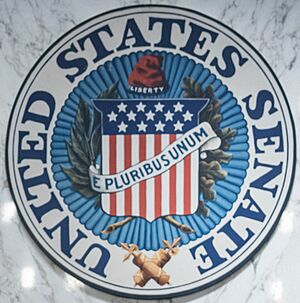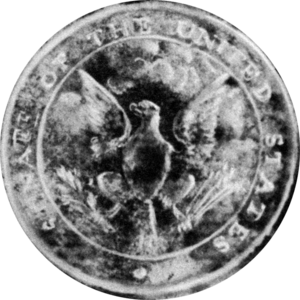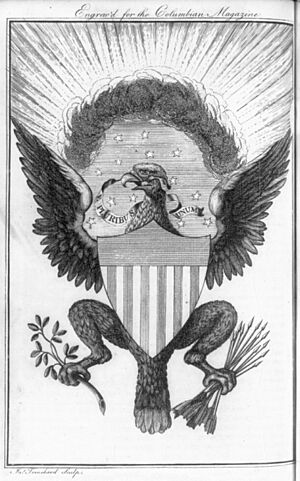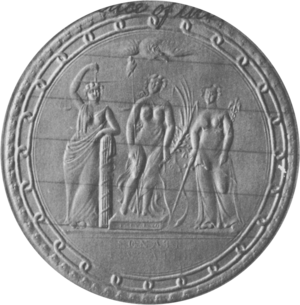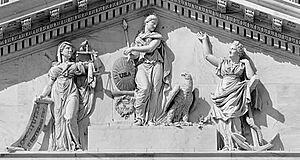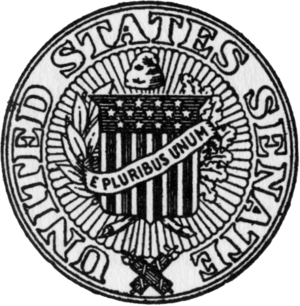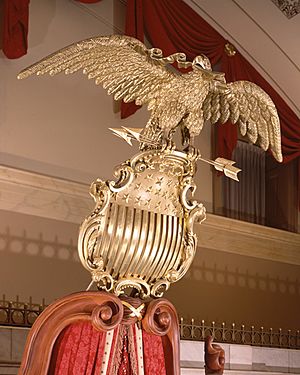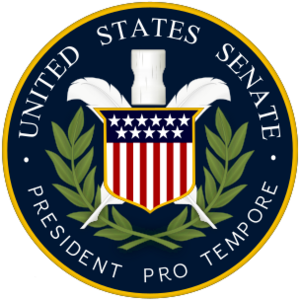Symbols of the United States Senate facts for kids
Quick facts for kids Seal of the United States Senate |
|
|---|---|
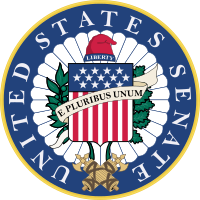 |
|
| Armiger | United States Senate |
| Adopted | 1886 |
| Crest | Liberty Cap |
| Blazon | Arms of the United States |
| Supporters | Olive and Oak branches |
| Motto | E pluribus unum |
| Other elements | Fasces |
| Earlier version(s) | 1798 and 1831 |
| Use | Sealing of Senate documents, and by the Senate Majority and Minority Leaders |
The United States Senate has many important symbols. These include its official seal, the "Eagle and Shield" sculpture, and the Senate gavel. These symbols help represent the Senate and its history.
Contents
The Senate Seal
The seal of the United States Senate is a special design used to show that official Senate papers are real. It also appears on the Senate's official flag and other places as a symbol. The current design was chosen in 1886. It is the third seal the Senate has used since it started in 1789.
The law limits how the seal can be used. Because of this, you often see other unofficial seal designs in public.
The Senate seal has a shield with 13 stars at the top and 13 stripes at the bottom. A scroll floats above the shield with the Latin words E pluribus unum (meaning "Out of many, one"). An olive branch is on the left side of the shield, showing peace. An oak branch is on the right, showing strength.
Above the shield is a red liberty cap, which stands for freedom. Below the shield are crossed fasces, which represent authority. Blue rays of light shine from behind the shield. Around the whole design are the words "United States Senate". Many parts of this seal are similar to the Great Seal of the United States.
How the Senate Seal is Used
The official seal is put on important documents like impeachment papers. It is also used on agreements with other countries, called international treaties. The seal appears on special copies of Senate decisions that recognize appointments or achievements. It also helps confirm the credentials of senators and the electoral votes for President and Vice President.
The Secretary of the Senate keeps the seal safe. The Secretary can also allow other specific uses. In recent times, the Secretary has allowed the majority and minority leaders to use it officially.
It is against the law to use the Senate seal in a way that makes people think the U.S. Government approves of something when it doesn't.
Where You Can See the Seal
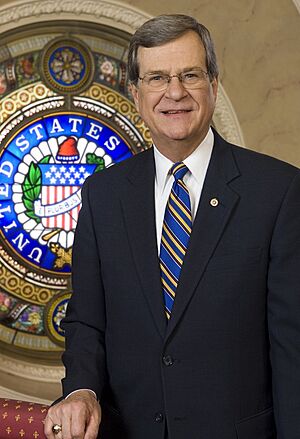
You can see the Senate seal in a beautiful stained glass window in the United States Capitol building. This window is on the Senate side of the Capitol. It replaced an older window that was accidentally broken in the 1960s. The image from this window was even used on the Senate's website for a few years.
The Senate did not have an official flag until the 1980s. In 1984, Senator Daniel Inouye suggested creating one using the seal's design. The Army Institute of Heraldry designed a navy blue flag with the seal in the center. This design was approved in 1987. These flags are only for Senate offices and cannot be used for business. A Senate flag also hangs in the main hearing room of the Hart Building.
The Senate seal was also used on the back of the 1998 commemorative dollar coin. It was paired with the seal of the Department of Justice. These seals honored Robert F. Kennedy's career as United States Attorney General and later as a senator from New York.
History of the Senate Seal
The First Seal (1790s)
When the Senate first met in Philadelphia in the 1790s, they liked the Great Seal of the United States. They decided to create their own seal with a similar design.
This first Senate seal showed an eagle with a shield on its chest. The eagle held olive branches in its left claw and arrows in its right. Above the eagle were rays of light coming from clouds, symbolizing the new nation. Around the design were the words "SENATE OF THE UNITED STATES".
This design was clearly based on the Great Seal. However, it had some differences. For example, the shield shape was different, and the eagle did not have a scroll in its beak. The design was actually closer to an image made by James Trenchard in 1786.
No one knows exactly when or by whom this first seal was made. Its first known use was in March 1798 on papers for the impeachment of Senator William Blount.
The Second Seal (1831)
By 1830, the first Senate seal was either too old to use or had been lost. A new seal was ordered from Robert G. Lanphier Jr., a French artist living in Washington D.C.. The tools to make the seal were created by Edward Stabler. Stabler had also made the seal for the House of Representatives in 1830.
This second design was inspired by old Greek and Roman art. It showed three female figures representing liberty, justice, and power. An eagle was above them. Twenty-four chain links around the edge showed the number of states in the Union at that time.
The central figure, Liberty, stood on a platform marked "4 JULY 1776". She held a pole with a Phrygian cap, a palm branch, and a scroll saying "CONSTITUTION, MARCH 4, 1789". The Justice figure held scales and leaned on fasces. The Power figure held a sword and a caduceus, which symbolized trade and peace.
This design was similar to the Genius of America sculpture on the Capitol building. That sculpture, made by Luigi Persico, also featured three female figures.
The second seal was used until 1880. It was found worn out after being used a lot during an impeachment trial in 1876.
The Current Seal (1886)
In 1876, the United States Centennial (100th birthday) made people more interested in national symbols. This led to a new design for the Great Seal in 1885. On March 31, 1885, the Senate decided to update its own seal. Many senators didn't even know a Senate seal existed!
The Senate chose a design by Louis Dreka, an engraver from Philadelphia. He was paid $35 to make the seal, which was about one-and-a-half inches wide. This is the design still used today. The actual seal is kept in a special mahogany cabinet.
At this time, rules were also made about who could use the seal and when. The Congressional Record stated that the Secretary of the Senate would keep the seal. The Secretary would use it to confirm official papers when the Senate directed. In recent times, the Secretary has allowed the majority and minority leaders to use the seal officially.
Unofficial Seals
Because the official Senate seal is only for official documents, other unofficial designs are often used as general symbols.
One unofficial seal shows an eagle holding arrows and an olive branch, surrounded by the words "United States Senate". This design is often seen in Senate offices and on items sold in the Senate gift shop. Even more common is a version of the Great Seal of the United States with a similar inscription. These often appear on Senate web pages and at podiums where senators speak. The House of Representatives also uses similar unofficial designs. Since the United States Congress does not have an official seal, similar designs are often used with a "Congress" inscription.
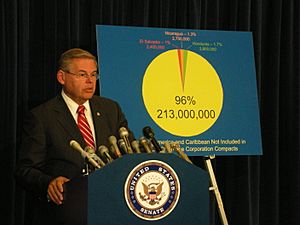
Using the official Senate Seal or Great Seal in a way that falsely suggests government approval is against the law. The Senate ethics rules say that using these seals for normal Senate business is fine. However, using them for business, personal reasons, or political campaigns is not allowed. The rules suggest that senators should use an image of the United States Capitol dome for campaign materials instead.
Other Senate Symbols
The Eagle and Shield
The Eagle and Shield is a large, gilded wood sculpture. It sits on the dais (raised platform) of the Old Senate Chamber. It has been there since the 1800s when the Senate used that room. The sculpture dates back to at least 1838. It was carved by Mr. Thomas C. Millard, a woodcarver from New York City.
The eagle is life-sized, measuring about 53.5 inches (135.9 cm) high and 72 inches (182.9 cm) wide. Its design comes from the Great Seal of the United States. When the Senate moved to its new rooms in 1859, the Supreme Court took over the Old Senate Chamber. The shield and eagle were separated. In 1976, after the Supreme Court moved to its own building, the two pieces were put back together on the dais. It has become a lasting symbol of the Senate.
A modern version of the Eagle and Shield has been used as a logo for the Senate's website since 2006. It is also used on several online Senate publications.
The Senate Gavel
The Senate gavel is a small hammer used by the person leading the Senate meeting. This is usually the Vice President or the President pro tempore. The gavel is used to start or end a Senate session.
The original gavel was made of ivory and had no handle. It was about 2.5 inches high. It was used as far back as 1831. Some stories say John Adams used it during the very first Senate meetings in 1789.
The original gavel became damaged in the 1940s. In 1952, silver pieces were added to try and fix it. However, in 1954, then-Vice President Richard Nixon hit it during a heated debate, and it broke completely. Officials wanted to make an exact copy, but they couldn't find enough ivory. So, they asked the government of India for help.
On November 17, 1954, the Vice-President of India, Sarvepalli Radhakrishnan, gave the Senate a new gavel. This new gavel is still used today. It is a copy of the original, but with a decorative floral band around the middle. Both the original and new gavels are kept in a mahogany box. Each day, a Senate page places the box on the desk of the presiding officer.
It is now a tradition for new senators to lead the Senate meetings for one-hour shifts. This helps them learn the Senate's rules and procedures.
The seal of the President pro tempore of the United States Senate includes a picture of the original gavel, even showing its cracks. It also has two quill pens and parts from the official Senate seal.


